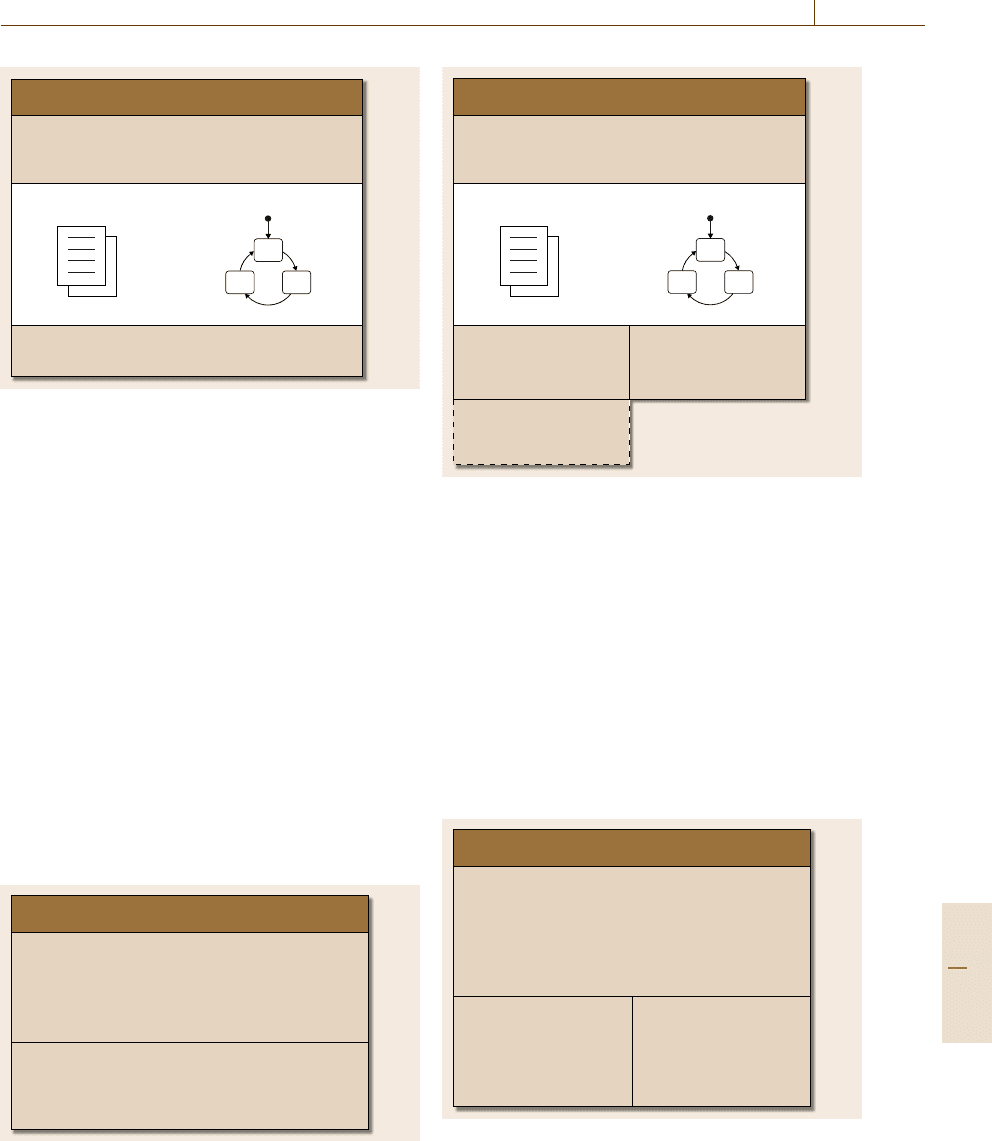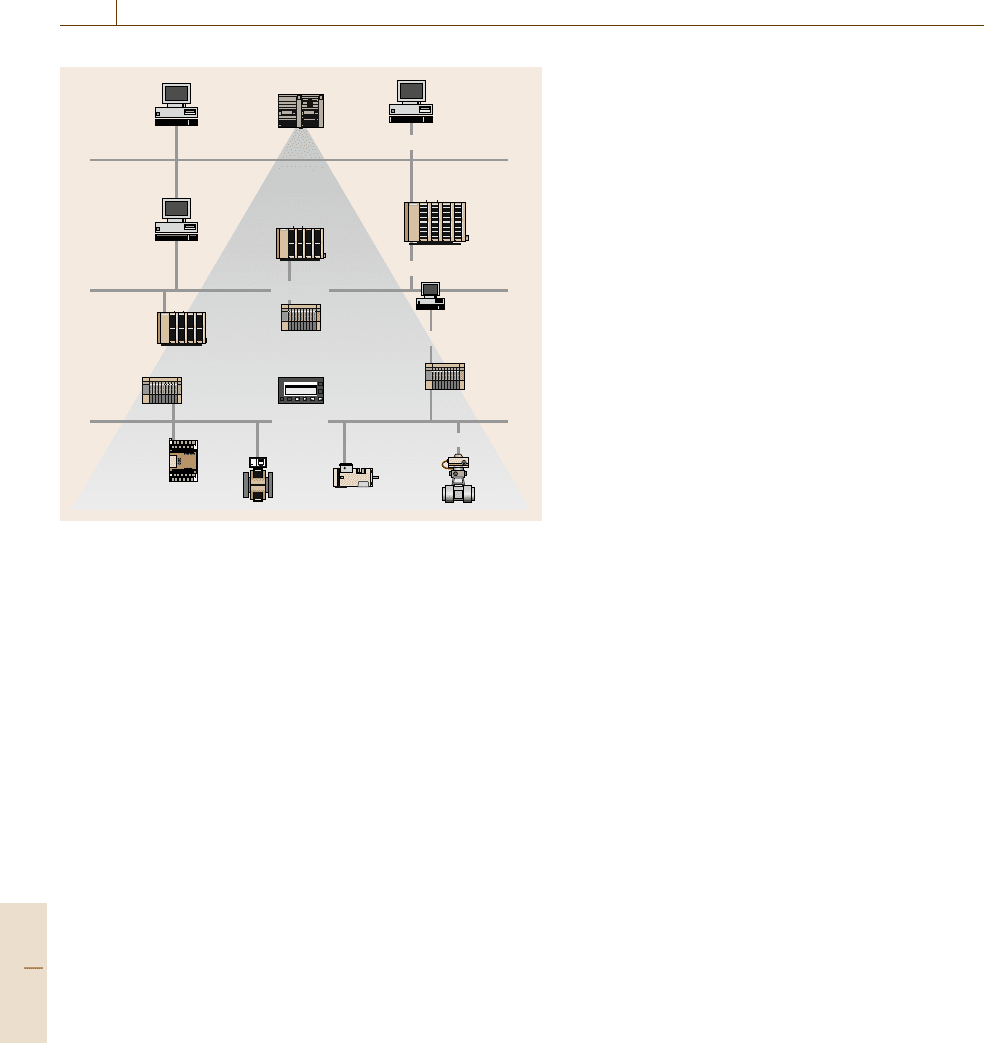Nof S.Y. Springer Handbook of Automation
Подождите немного. Документ загружается.


Software Management References 795
45.7 LANDesk Software Ltd.: Solutions Brief (LANDesk,
South Jordan 2007), http://www.landesk.com
45.8 Akamai Electronic Software Delivery: Business Ben-
efits and Best Practices (Akamai, Cambridge 2007),
http://www.akamai.com/dl/whitepapers
Akamai_ESD_Whitepaper.pdf
45.9 B.W. Boehm: Software Engineering Economics
(Prentice Hall, Upper Saddle River 1981)
45.10 C. Jones: Software cost estimating methods for
large projects, Crosstalk (2005), http://www.stsc.
hill.af.mil/crosstalk/2005/04/0504Jones.html
45.11 S. McConnell: After the Gold Rush, 2004 Systems
and Software Technology Conference (Salt Lake City
2004)
45.12 C.A. Dekkers: Creating requirements-based esti-
mates before requirements are complete, Crosstalk
(2005), http://www.stsc.hill.af.mil/crosstalk/2005/
04/0504Dekkers.html
45.13 T.L. Saaty: The Analytic Hierarch Planning Pro-
cess: Planning, Priority Setting, Resource Allocation
(McGraw-Hill, New York 1980)
45.14 L.H. Putnam, D.T. Putnam, D.H. Beckett: A method
for improving developer’s software size estimates,
Crosstalk (2005), http://www.stsc.hill.af.mil/
crosstalk/2005/04/0504Putnam.html
45.15 B.W. Boehm, R. Valerdi, J.A. Lane, A.W. Brown:
COCOMO suite methodology and evolution, Crosstalk
(2005), http://www.stsc.hill.af.mil/crosstalk/2005/
04/0504Boehm.html
45.16 L. Fischman, K. McRitchie, D.D. Galorath: Inside
SEER-SEM, Crosstalk (2005), http://www.stsc.hill.af.
mil/crosstalk/2005/04/0504Fischman.html
45.17 R.D. Patton: What can be automated? What cannot
be automated?. In: Springer Handbook of Automa-
tion, ed. by S.Y. Nof (Springer, Berlin, Heidelberg
2009), Chap. 18
Part E 45
“This page left intentionally blank.”

797
Practical Auto
46. Practical Automation Specification
Wolfgang Mann
This chapter specifies equipment-based control
system structures for complex and integrated
systems and describes the approach to and im-
plementation of an equipment-based control
strategy. Based on a view of subsystems in a pro-
duction, process or a single machine the control
system has to abstract the subunits in an object-
oriented manner to obtain their methods and
properties. The base subunits will run as sep-
arate state machines (either on centralized or
decentralized control devices) representing them-
selves to the next control hierarchy level only by
said methods and properties. These base sub-
units form functional subsystems in the same
way.
Advantages of such a modular specification
are: easy replacement of different base units with
the same functionality to the next hierarchy level,
high efficiency in construction kit engineering of
systems, easy integration of systems to vertical
integration attempts – especially in the field of
networking and data concentration. The challenge
is the implementation on standard industrial
programmable logic controller (PLC) systems with
a standard industrial-like programming language
(e.g., EN 61131). An example demonstrates the
implementation in a modern test stand for heat
meters for the German Physikalisch-Technische
Bundesanstalt (PTB) institute, a system with about
46.1 Overview.............................................. 797
46.2 Intention ............................................. 798
46.2.1 Encapsulation............................ 798
46.2.2 Generalization (Inheritance)........ 799
46.2.3 Reusability ................................ 799
46.2.4 Interchangeability...................... 799
46.2.5 Interoperability.......................... 800
46.3 Strategy............................................... 800
46.3.1 Device Drivers ............................ 800
46.3.2 Equipment Blocks ...................... 801
46.3.3 Communication ......................... 802
46.3.4 Rules ........................................ 802
46.4 Implementation ................................... 803
46.5 Additional Impacts ............................... 803
46.5.1 Vertical Integration and Views ..... 803
46.5.2 Testing...................................... 804
46.5.3 Simulation ................................ 804
46.6 Example .............................................. 804
46.6.1 System...................................... 806
46.6.2 Impacts..................................... 807
46.6.3 Succession................................. 807
46.7 Conclusion ........................................... 807
46.8 Further Reading ................................... 807
References .................................................. 808
1000 physical input/output (I/O) and measurement
points.
46.1 Overview
Complex systems with many dozens of subsystems
become increasingly challenging in terms of program-
ming, interfacing, andcommissioning, inboth operation
and maintenance.
The reasons for this intricacy are multifarious and
include [46.1]:
1. Product lifecycles getting shorter, and even techno-
logical cycles getting shorter.
2. Orders to stock are replaced by short orders to
delivery.
3. Change form self-production to integration of sub-
suppliers.
Part E 46

798 Part E Automation Management
4. Decentralized stock and service.
5. High price pressure.
6. Change form manually process integration to inte-
grated processes.
7. Change from product supplier to system supplier.
8. Production processes control multiple enterprises.
9. e-Commerce and quality management systems ad-
ditionally produce enormous quantity of data and
force the introduction of data management through-
out the company.
These requests can be covered by a horizontal
and vertical integration of process and production
systems and subsystems within the company and ex-
tending thenetwork tosuppliers and evencustomers. So
the systems become more complex, open, distributed,
and heterogeneous. Dataflow often has to be imple-
mented throughout the complete enterprise hierarchy
form the shop floor area to enterprise management
level.
To address these attempts, new software concepts
have to be implemented throughout the complete infor-
mation chain within an enterprise, starting at the I/O
level of the production line.
Although there are well-developed methods and
strategies to produce well-structured, reusable, and so-
phisticated code in the information technology (IT)
personal computer (PC)-based environment, industrial
control at its base level is still done using standard PLC
systems with EN 61131-like programming language us-
ing functional blocks, structured text or instruction lists
at large scale [46.2].
As long as the projects are small and centralized
a programming technique limited to the I/Os of indus-
trial controllers and their periphery is applicable, with
some restrictions.
However, with the above-stated imperative demands
in mind, conventional I/O-based engineering attempts
leads to unstructured, error-prone code, resulting in cost
overruns during installation and operation.
We consider the traditional PLC programming style
more as an expression of old-fashioned thinking, hav-
ing its tradition as far back as relay-based times, rather
than an exigency coming from existing hardware and in
particular software systems.
Before the implementation strategy is described, we
look for the must-haves to overcome the shortcomings
of traditional industrial control programming.
46.2 Intention
Many of the following topics have been implemented
for years on IT-based systems using C++, Java or other
object-oriented (OO) languages. Some of these have
found their way into the International Electrotechnical
Commission (IEC) 61499 function blocks (with a lack
of practical implementations untill now), but actually
the bulk of industrial control applications is still done
on EN 61131-based systems. So, in the following, fo-
cus is placed on the implementation on these existing
systems [46.3].
46.2.1 Encapsulation
The most important part of changing the thinking in the
traditional control programming approach isto leavethe
physical I/O connections as the primary way of compo-
sition and interaction of systems.
Normally an object in the real world is experienced
by humans through its properties, attributes, features
(however named), and the possibilities it offers or what
we can do with this object (called methods). In general
we realize this object only in a certain abstracted layer.
The level of this abstraction is chosen according to our
actual demands.
As an example we take a human being (a car me-
chanic). If our car is broken, we abstract him as an
object: human with the attributes educated, skilled on
certain brand, available, etc., and his methods: takes
order, repairs car, renders account, etc. We are not in-
terested in how the blood flows through his veins, how
his heart functions, etc. His doctor on the other hand is
interested in exactly these methods and attributes. He
will abstract him as object: human with the attributes:
sex, age, blood pressure, etc. and methods: sees, smells,
tastes, etc.
Coming back to automation. We are interested in
automated systems for production and processes, con-
trol and testing, etc. Usually complex systems are built
as a network of subsystems (objects) based again on
a network of subsystems.
In our namespace these subsystems are called
equipment. The term equipment could lead to some
unaesthetic grammar constructs in the following, but
we have chosen it intentionally: firstly, equipment ex-
Part E 46.2

Practical Automation Specification 46.2 Intention 799
presses things we need for some activities, especially in
production, and secondly it is already a plural expres-
sion, although it could be a single device or the whole
factory. So it represents the modularity of the method
downto thesmallest base modules (that in general again
consist of parts).
We differentiate between base equipment and ab-
stracted equipment. A motor, a valve or a pump is
a single base equipment. A pump station, for example,
is a single abstracted equipment.
What is the definition of base equipment in contrast
to abstracted equipment? A base equipment implements
interface access via physical I/Os to the real world,
whereas an abstracted equipment implements interface
access to physical I/Os only via base equipment. Nev-
ertheless base equipment can of cause host other base
equipment (see Sect.46.2.2 as well).
The intention for building equipment is to en-
capsulate the actual physical implementation of one
subsystem from the collaboration with other subsys-
tems, as well as to support the abstraction of these
systems for different service subscribers (with different
interests, e.g., production, service, and management) to
its methods and/or properties.
The encapsulation consists of three layers: the in-
terface layer (providing abstracted methods and proper-
ties), the implementation layer (running the algorithms,
the event routines, and the exception routines), and
the base layer. The base layer is the interface to the
physical I/Os and the access to the implementation
layer of subequipment for base equipment and the
same without direct access to physical I/Os for abstract
equipment.
Access from one single equipment to another is al-
lowed only by use of its interface layer. This strict
access method allows one to change the implementa-
tion layer as well as the base layer of equipment without
affecting how it is accessed.
46.2.2 Generalization (Inheritance)
In the implementation of object-oriented languages
the method of inheritance is an important feature. It
describes the deployment from more generic objects
to more specialized ones. As in the following im-
plementation we have no special software tools in
standard EN 61131-based systems for constructing
strict inheritance (as is possible in C++), we talk about
generalization and bear in mind the underlying ideas.
So, for our needs, generalization allows hierarchical
structures and establishes a relationship between a more
general equipment and a more specific one, without
redefining all the specific methods and properties, al-
though if required it is possible to override the generic
methods and properties of the generic equipment with
more specific ones.
To follow our first example, a woman inherits all
the methods and properties of the object human, but has
of course more specific attributes and methods, most
importantly to give life to new humans. We will give
more technical examples in the implementation sec-
tion.
46.2.3 Reusability
Probably it is the basic idea of every engineer to built
up a system (whichever) out of already existing, used,
and tested parts coming from a toolbox (as children do
when playing Lego) to create new systems and projects.
By doing this an engineer mostly thinks about saving
time, lowering risks, and reducing overall costs.
The basis for doing this is encapsulation and the
concept of instances. As a single equipment is the
implementation of methods and at the same time its
abstraction, and the base layer is the interface to the
physical world, it is only a general construct. The base
equipment, e.g., is brought to life when it is con-
nected via its interface to defined physical I/O points
and placed as a defined instance in the state machine
call (see the implementation section); for example,
we define an equipment pump with all its methods
and properties, but only when we have certain pumps
(FreshwaterPump01, WasteWaterPump01, ...) instan-
tiated in our project will water flow.
So with these concepts we are able to forget the
internal details of the equipment for all future im-
plementations of the same sort of pump and can
concentrate on the method and property interface.
46.2.4 Interchangeability
Interchangeability has a strong relation to reusability as
it is based on the same concepts, although it describes
another topic.
Reusability refers to the ability to use the same
equipment without major efforts again in the same
or another project. Interchangeability applies when we
want to replace existing equipment with another type
of equipment, but with the same functionality. Accord-
ing to our encapsulation approach, equipment with the
same functionality should have the same interface layer,
although the implementation layer and the base layer
Part E 46.2

800 Part E Automation Management
are different. We advise strict application of this rule, at
least for base equipment.
Consider, for example, that one has to change
a pump with all its control and monitoring periphery
for any reason (customer demand, unavailability, etc.)
with one from another manufacturer. It is evident that
often the physical implementation of the machine will
be different, even though it has the same functionality.
Having two equipments describing the two pump
systems with the same interface layer makes software
changes possible in a matter of minutes.
46.2.5 Interoperability
As long as the defined equipment runs on a central-
ized system, communication between them leads to no
trouble. As we pointed out in the Introduction systems
nowadays are highly complex and distributed, so we
need implementation concepts to simplify access be-
tween equipment even in high-grade networked and
heterogeneous environments,starting at low controllev-
els with existing equipment.
We will not describe all the systems and attempts in
hardware and software that exist or are in development,
which could fill books. We only want to focus on the
way we structure the issue.
As pointed out in the paragraph on encapsulation,
the only way of accessing other equipment is by using
the interface layer. As a fetch-ahead of the implemen-
tation, we will see that this interface is not part of
the equipment functions, but is a separate, generally
available data structure. For the time being, this data
structure is only composed of basic data types.
As a paradigm we do not allow the implementation
layer of a single equipment to be spread over sev-
eral controllers. This seems like a strong restriction on
first reflection, but it enforces well-elaborated encap-
sulation, and good and fine-structured systems. As an
additional advantage, it simplifies equipment communi-
cation, which is one of our aims.
46.3 Strategy
46.3.1 Device Drivers
As we defined in the paragraph on encapsulation the
basis of every system is its base equipment – the equip-
ment connected directly to the physical world. We
consider this equipment like device drivers in the PC
environment. In the same way that a program in Win-
Equipment
Control
valve
Discrete
configuration:
Motor
Status pot
Limit switches
Discrete
Digital I/O
Analog I/O
µC based
positioner
Bus based
Profibus
Fieldbus
Methods:
GoPosition 50%
Open
Close etc.
Properties:
Position 50%
Status
FailureNr etc.
Equipment interface
Electric Pneumatic
Physical interface
Physical
implementation
SW implementation
Implementation layer
Communication
Base layer
Device driver
Fig. 46.1 Example of a single base equipment (control valve)
dows does not care about the actual physical mouse
type connected to the computer, but only the abstracted
events, other base or abstracted equipment does not
care about the physical implementation of the accessed
equipment.
All base equipment, at least, is implemented in the
implementation layer as a state machine, executing the
functions necessary to the actual state and checking all
allowed transitions to switch to another. Typically an-
other cycle is used to catch all possible exceptions.
Figure 46.1 shows the example of a control valve
(base equipment) with two possible physical and
software implementations. The left column in the im-
plementation part depicts a discrete built-on electric
valve with a motor, a potentiometer providing feed-
back, and limit switches for the end positions. In this
case the implementation layer has to build up the com-
plete functionality of the valve, such as the control of
the motor, the control loop with the feedback poten-
tiometer, etc. In the right column a micro controller
(µC) positioner-based pneumatic valve is represented.
Here the implementation layer has to manage mainly
the communication to the µC positioner, as the control
itself is done by the external logic.
Additionally the independency of the physical im-
plementation is visible. As the electrical valve is
Part E 46.3

Practical Automation Specification 46.3 Strategy 801
Interface
layer
Discrete
Bus based
Central
Decentral
Equip 01
Methods: Meth01, Meth02, ...
Properties: Prop01, Prop02, ...
Physical I/O:
Algorithms State machine
Implementation
layer
Base
layer
State
01
State
02
State
03
Trans01
Trans02
Trans03
Fig. 46.2 Example of a specifying single base equipment
(equipment block diagram); Equip01 does not use other
equipment, accessing only physical I/O
connected via the base interface to discrete I/O,the
pneumatic valve is running on a bus system.
Nevertheless the interface layer is the same, and we
can control both valve types from higher-level equip-
ment with a handful of methods and properties. So we
fulfill at least the demands for encapsulation, reusabil-
ity, and interchangeability.
46.3.2 Equipment Blocks
To model a complex system a graphical representa-
tion of its equipment is helpful. We choose a unified
modeling language (UML) class-like representation, al-
though the diagram has an additional area for the base
layer [46.4].
Figure 46.2 shows an equipment block for a sin-
gle base equipment interfacing the base layer singly to
Interface
layer
Motor 01
Methods: Start, stop, break, ...
Properties: Running, stopped,
break status, error,
errorNO
Physical I/O:
Motor relay on, break on,
relay/protection feedback
Base
layer
Fig. 46.3 Specifying implementation of single base equip-
ment (relay/motor protection controlled motor)
Interface
layer
Meth01, Meth02, ...
Prop01, Prop02, ...
Central
Decentral
Discrete
Bus based
Equip 11
Methods: Meth11, Meth01, ...
Properties: Prop11, Prop01, ...
Interface Equip01: Physical I/O:
Physical I/O
Equip01
Algorithms State machine
Implementation
layer
Base
layer
State
01
State
02
State
03
Trans01
Trans02
Trans03
Fig. 46.4 Specifying generalization of single base equip-
ment
physical I/O and not to other equipment. The implemen-
tation layer is not a must for the diagram representation,
but can be used for clarification of the actual execution
of the equipment.
Figure 46.3 depicts the diagram for a simple motor
with a brake controlled only by a relay–motor protec-
tion switch combination with feedback contacts.
Figure 46.4 shows a more specific equipment inher-
ited from a general one. Equip11 will use the methods
and properties of Equip01, adding some specific new
methods and properties by implementing additional
Interface
layer
Motor 11
Methods: Start, stop, break, hold,
changeDirection, changeFrequency
Properties: Running, stopped, direction,
frequency, break status,
error, errorNo
Physical I/O:
DirectionInput,
FrequencyAl,
FrequencyAO, ...
Interface Motor01:
Start, stop, break,
running, stopped,
error, errorNo
Base
layer
Fig. 46.5 Specifying implementation of single base equip-
ment based on generalized base equipment (motor con-
trolled by frequency converter)
Part E 46.3

802 Part E Automation Management
physical IO and/or by implementing new algorithms
and transitions in the interface of Equip01.
Figures 46.4 and 46.5 demonstrate the generaliza-
tion (inheritance) of equipment in general based on the
example of a more sophisticated implementation of the
motor controlled by a frequency converter unit. Bear
in mind that there are no automatic mechanisms for
inheritance in EN 61131 as in object-oriented program-
ming (OOP) languages.Nevertheless, we implementthe
underlying idea and call the method generalization to
indicate the difference.
Equip11 can forward the interface layer of Equip01
to its own interface layer or can override certain
methods and properties of Equip01 as its own imple-
mentation.
Figure 46.5 depicts a motor controlled via an intel-
ligent frequency converter. It is derived from the more
general Motor01 shown in Fig.46.3. Depending on the
actual implementation, the interface of Motor01 can be
forwarded directly to the interface layer of Motor11, or
some methods and/or properties have to be overridden.
Figure 46.6 represents a single abstract equipment,
built up on two sublevels, as Equip02 accesses another
equipment. Euip21 is abstract, as it does not access
physical I/O directly.
Interface
layer
Meth11, Meth12, ...
Prop11, Prop12, ...
Equip 21
Methods: Meth21_1, Meth11, Meth21, ...
Properties: Prop21_1, Prop11, Prop21, ...
Interface Equip01:
Meth21, Meth22, ...
Prop21, Prop22, ...
Interface Equip02:
Phys. I/O
Equip02
Interface
Equip0X
Physical I/O
Equip01
Algorithms State machine (optional)
Implementation
layer
Base
layer
State
01
State
02
State
03
Trans01
Trans02
Trans03
Fig. 46.6 Abstract equipment (does not access physical
I/O directly)
46.3.3 Communication
As stated above, communication between equipment is
allowed only through use of the interface level. For
communication between equipment on the same con-
trol unit, shared data blocks are used in general. For
homogenous distributed systems all open or proprietary
transfer mechanisms are allowed, ensuring coherent
data transfer.
For data communication between heterogeneous
distributed systems a standardized communication pro-
tocol has to be used. As object linking and embed-
ding (OLE) for process control (OPC) data access
(DA) is widespread, we normally use this proto-
col. As version 2 of this protocol does not support
well-structured data, the interface layer data has to
built up by basic data types only when using OPC
DA 2.
With broad distribution of OPC DA 3orOPC ex-
tensible markup language (XML) data access (OPC
XML-DA) this constriction will vanish in the fore-
seeable future, reducing implementation time for the
interface communication [46.5].
Special attention has to paid to access to the inter-
face layer of a single equipment by another equipment.
As indicated in Figs. 46.4 and 46.6, in general, a sin-
gle subequipment is embedded into another equipment
only via connecting the interface layer of subequipment
to the base layer of theaccessing equipment. In this way
we will obtain a well-structured and strictly hierarchical
system.
An exception to this rule has been implemented
for accessing data of interest to a group of equipment,
bypassing this strict hierarchical system. A separate
handler extracts filtered data from the interface layer of
defined equipment, stores it in separated data blocks,
and present these to a certain interface of the imple-
mentation layer. In general we use this outlier only for
exception handling.
46.3.4 Rules
As the following implementation will be done on stan-
dard EN 61131-based systems, the following rules have
to be implemented as a design guide, as these ex-
isting systems do not force the engineer to act in
an equipment-oriented way. On the other hand, only by
Part E 46.3

Practical Automation Specification 46.5 Additional Impacts 803
using a C++ compiler, nobody is barred from writing
unstructured code in an objectless method. The rules
are:
1. Encapsulation is a must: no direct access to the
physical level other than by distinctive base equip-
ment.
2. Abstraction has to be forced to the highest level
possible, which makes especially interchangeability
simple.
3. Interequipment communication has to be done only
by use of the interface level (methods and proper-
ties).
4. Generalization has to be used whenever possible.
5. The use of abstract equipment should be done in the
lowest possible level.
6. Implementation of one single equipment on a single
controller (no implementation of algorithms or state
machines in the implementation layer via more then
one controlling unit).
46.4 Implementation
As pointed out at the beginning, in this chapter we want
to focus on the implementation of the topics elaborated
so far for EN 61131-based PLCs, since this poses a par-
ticularly challenge.
We have chosen the implementation in instruction
list form, as the flexibility of this method in general
is the largest for most control systems. Nevertheless
one can use structured text or function block diagrams;
ladder diagrams or sequential function charts are not
adequate [46.2].
All equipment is implemented in function blocks;
each instanceof the function block represents a physical
unit for base equipment or a certain virtual or composed
unit for abstract equipment.
The baselayer is represented by the function block’s
own encapsulated data block, whereas the interface
layer is represented by a separate, general data block,
unique for each implementation of the equipment. This
allows simple data communication and easy multiple
access for different higher-level equipment.
For base equipment a state-machineimplementation
is a must, although abstract equipment should also use
this method if it makes sense.
All base equipment function block are called cycli-
cally by a service routine and run their state-machine
functions. Implementing this approach, at least er-
ror handling is done for all devices, independently of
whether the device is actually used or not. This is a ma-
jor advantages for early failure detection. The way of
connecting physical I/Oto baseequipment is not limited
and could be either discrete on a centralized unit or via
fieldbuses, Ethernet or even wireless for decentralized
peripherals.
As mentioned earlier, one homogenous control unit
is responsible for implementing the algorithms and
state-machine functions for a single equipment, i.e.,
such a control unit can of course host a large number
of equipments, but the implementation layer of one sin-
gle equipment cannot be executed by several control
devices.
So, considering the communication aspect, even in
heterogeneous networked systems different communi-
cation methods simply have to map the interface data
blocks to the participating control units in a coherent
manner.
Practically we use system-specific communication
methods, as long we are working in homogenous plat-
forms, because they are in general more efficient. If
we leave the homogenous domain, we normally use
OPC DA and OPC AE (alarms and events) [46.5].
Because we do not mix data with data com-
munication in our strategy, functional engineering
and data communication setup can be handled sepa-
rately.
46.5 Additional Impacts
46.5.1 Vertical Integration and Views
In the Introduction of this chapter we found that ver-
tical integration of processes is an answer to many of
the demands of modern business [46.6]. Figure 46.7
represents the business as well as the communica-
tion pyramid in a contemporary enterprise. Nowadays
the control level is the domain of PLCs, whereas
Part E 46.5

804 Part E Automation Management
IT
Enterprise planning
Factory management
Production management
Process level
ERP
MES
Control
Data
Field
SCADA
Fig. 46.7 Business and communication pyramid in a modern enter-
prise
supervisory control and data acquisition (SCADA),
manufacturingexecutionsystems (MES),and enterprise
resource planning (ERP) are the domains of PC-based
devices [46.7].
With the implementation of an equipment-based
programming structure at the control level we overcome
the existing gap between the field and the data/IT level.
As many enterprise MES and ERP solutions are
already object oriented, equipment-based control struc-
tures can easily be mapped to objects in higher-level
applications, as the equipment constructs are built up
in a class-like manner [46.7].
The hierarchical structure of the equipment imple-
mentation follows the natural business pyramid, and
the encapsulation and abstraction support the inherent
enforcement of data reduction in the lower field level.
46.5.2 Testing
A major part of resources during the development of
a system is spent on testing its functionality and excep-
tion handling. By using software strategies with a clear
hierarchical structure, a modular concept with a strictly
defined interface layer architecture, these resources can
be dramatically reduced, concurrently increasing per-
formance and stability.
46.5.3 Simulation
Another attempt to reduce testing resources is the
simulation of systems or subsystems of a project. If
a simulation is connected to real hardware, we speak of
hardware in the loop simulation. In testing developed
equipment, one can differentiate between two cases.
The higher-level equipment accessing the part to be
tested is simulated, or a lower-level part we want to
access is simulated.
In both cases the concept of equipment-based
structures simplifies the simulation part. Firstly, most
simulation tools are object oriented, so we are able
to map our equipment easily to their classes. Second
the simulation environment has to model only the ab-
stracted interface layer of the simulated subsystem,
rather than simulating all the necessary I/Os.
46.6 Example
Profactor, amongst others, has been a supplier of test
stands for heat and flow meters for 20 years; addition-
ally theautomation group of ARC-srdelivers innovative
automation solutions for the process and production in-
dustry and also develops new automation processes for
a couple of sectors [46.8].
In 2000 Profactor was put in charge of building
one of the largest and most modern test stands for heat
meters in Berlin. The customer was the well-known
Physikalisch Technische Bundesanstalt (PTB) [46.9].
In addition to building up the mechanics and mea-
surement system, challenging the frontiers of today’s
realizability, the test stand had to be embedded into an
overall test administration system. This started with the
management of customers, test orders, and devices un-
der test, and ended with management of test reports
and quality management for the test stand with its own
subsystems.
As the system for the PTB was the most complex
test stand ever, incorporating about 1000 physical I/O
and measurement points, including dozen of subsys-
tems, and has to be vertically integrated into the testing
hierarchy of the PTB, Profactor decided to implement
the described system for the actual and future system
as well as for other complex systems in their field of
activities [46.10].
Part E 46.6
